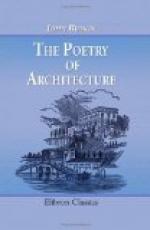209. The garden of the Elizabethan villa, then, should be laid out with a few simple terraces near the house, so as to unite it well with the ground; lines of balustrade along the edges, guided away into the foliage of the taller trees of the garden, with the shadows falling at intervals. The balusters should be square rather than round, with the angles outward; and if the balustrade looks unfinished at the corners, it may be surmounted by a grotesque bit of sculpture, of any kind; but it must be very strong and deep in its carved lines, and must not be large; and all graceful statues are to be avoided, for the reasons mentioned in speaking of the Italian villa: neither is the terraced part of the garden to extend to any distance from the house, nor to have deep flights of steps, for they are sure to get mossy and slippery, if not superintended with troublesome care; and the rest of the garden should have more trees than flowers in it. A flower-garden is an ugly thing, even when best managed: it is an assembly of unfortunate beings, pampered and bloated above their natural size, stewed and heated into diseased growth; corrupted by evil communication into speckled and inharmonious colors; torn from the soil which they loved, and of which they were the spirit and the glory, to glare away their term of tormented life among the mixed and incongruous essences of each other, in earth that they know not, and in air that is poison to them.
210. The florist may delight in this: the true lover of flowers never will. He who has taken lessons from nature, who has observed the real purpose and operation of flowers; how they flush forth from the brightness of the earth’s being, as the melody rises up from among the moved strings of the instrument; how the wildness of their pale colors passes over her, like the evidence of a various emotion; how the quick fire of their life and their delight glows along the green banks, where the dew falls the thickest, and the mists of incense pass slowly through the twilight of the leaves, and the intertwined roots make the earth tremble with strange joy at the feeling of their motion; he who has watched this will never take away the beauty of their being to mix into meretricious glare, or feed into an existence of disease. And the flower-garden is as ugly in effect as it is unnatural in feeling: it never will harmonize with anything, and if people will have it, should be kept out of sight till they get into it.
211. But, in laying out the garden which is to assist the effect of the building, we must observe, and exclusively use, the natural combinations of flowers.[42] Now, as far as we are aware, bluish purple is the only flower color which Nature ever uses in masses of distant effect; this, however, she does in the case of most heathers, with the Rhododendron ferrugineum, and, less extensively, with the colder color of the wood hyacinth. Accordingly, the large rhododendron may be used to almost any extent, in masses; the pale varieties of the rose more sparingly; and, on the turf, the wild violet and pansy should be sown by chance, so that they may grow in undulations of color, and should be relieved by a few primroses. All dahlias, tulips, ranunculi, and, in general, what are called florist’s flowers, should be avoided like garlic.




